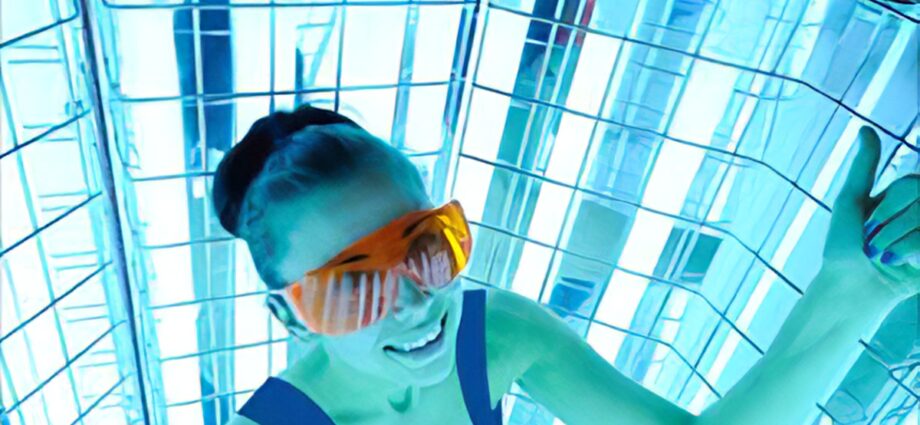Contents
PUVA therapy
What is PUVA therapy?
Definition of PUVA therapy
PUVA therapy combines exposure to an artificial source of UVA radiation with treatment based on psoralen, a UV sensitizing product. Hence the acronym PUVA: P referring to Psoralen and UVA to ultraviolet rays A.
The principle
Exposure to UVA will cause the secretion of substances called cytokines, which will have two actions:
- a so-called antimitotic action, which will slow down the proliferation of epidermal cells;
- an immunological action, which will calm the inflammation.
The indications for PUVA-therapy
The main indication for PUVA-therapy is the treatment of severe psoriasis vulgaris (drops, medallions or patches) spread over large areas of the skin.
As a reminder, psoriasis is an inflammatory disease of the skin due to too rapid renewal of the cells of the epidermis, the keratinocytes. As the skin does not have time to eliminate itself, the epidermis thickens, the scales accumulate and then come off, leaving the skin red and inflamed. By calming inflammation and slowing the proliferation of epidermal cells, PUVAtherapy helps reduce psoriasis plaques and space out flare-ups.
Other indications exist:
- atopic dermatitis when the outbreaks are very important and resistant to local care;
- early stage cutaneous lymphomas;
- photodermatoses, such as summer lucitis for example, when the photoprotective treatment and sun protection are insufficient;
- polycythemia pruritus;
- skin lichen planus;
- some cases of severe alopecia areata.
PUVA therapy in practice
The specialist
The PUVA-therapy sessions are prescribed by a dermatologist and take place in an office or in a hospital equipped with an irradiation cabin. They are covered by Social Security after acceptance of the request for prior agreement.
Course of a session
It is important not to apply anything to the skin before the session. Two hours before, the patient takes a psoralen by mouth, or more rarely topically, by immersing part of the body or the whole body in an aqueous solution of psoralen (balneoPUVA). Psoralen is a photosensitizing agent making it possible to increase the effectiveness of UV treatment.
UVA can be administered all over the body or locally (hands and feet). A session lasts from 2 to 15 minutes. The patient is naked, with the exception of the genitals, and must wear dark opaque glasses to protect themselves from UVA rays.
After the session, it is important to wear sunglasses and avoid sun exposure for at least 6 hours.
The frequency of the sessions, their duration and that of the treatment are determined by the dermatologist. The rhythm of the sessions is usually several sessions per week (generally 3 sessions spaced 48 hours apart), delivering gradually increasing doses of UV. About 30 sessions are needed to get the desired result.
It is possible to combine PUVA therapy with another treatment: corticosteroids, calcipotriol, retinoids (re-PUVA).
Contraindications
PUVA therapy is contraindicated:
- during pregnancy and lactation;
- in the event of the use of photosensitizing drugs;
- liver and kidney failure;
- skin conditions caused or aggravated by ultraviolet light;
- skin cancer;
- damage to the anterior chamber of the eye;
- acute infection.
Side effects and risks
The main risk, in the event of numerous PUVA therapy sessions, is that of developing skin cancer. This risk is estimated to be increased when the number of sessions, combined, exceeds 200-250. Also before prescribing sessions, the dermatologist performs a complete skin assessment to detect in the patient a possible individual risk of skin cancer (personal history of skin cancer, previous exposure to X-rays, presence of pre-cancerous skin lesions, etc.) . At the same time, annual dermatological monitoring is recommended in people who have received more than 150 phototherapy sessions, in order to detect precancerous lesions or early cancer at an early stage.
Mild side effects are frequently observed:
- nausea due to taking Psoralen;
- skin dryness requiring the application of an emollient;
- an increase in hairiness which will fade when the sessions stop.










